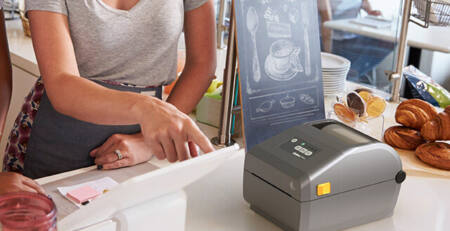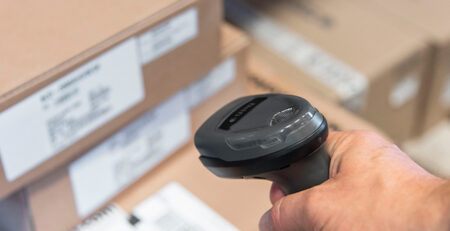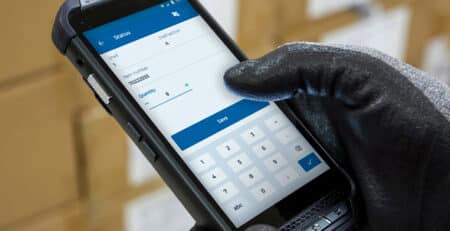Choosing a hand scanner
Efficient inventory management, fast checkout processing and flawless item tracking - a handheld scanner is an indispensable part of modern business operations.
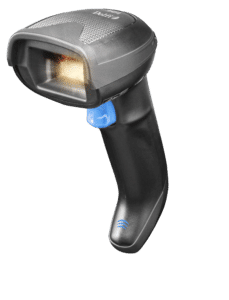
Efficient inventory management, fast checkout processing and flawless item tracking – a handheld scanner is an indispensable part of modern business operations. But how do you choose the best hand scanner for your business? With so many models on the market, finding the right solution can be a challenge. Should it be wireless or wired? Should it scan 1D or 2D barcodes? Should it be drop, dust and water resistant?
In this guide, we review the most important factors to help you make the right choice. Whether you run a retail store, warehouse or manufacturing business, we’ll help you find the best handheld scanner to match your needs.
Read on to find your next hand scanner – and avoid expensive mistakes!
Wired or wireless – what’s best for your business?
When choosing the best handheld scanner for your business, the first question is often: Wired or wireless? Both types have their advantages, depending on how and where the scanner will be used.
Wired handheld scanners – stability and reliability
If you primarily scan items at a fixed workstation – for example, at a cash register in a retail store or on a fixed storage table – a wired handheld scanner may be the best solution. Benefits include:
✅ Uninterrupted operation – No battery life to worry about.
✅ Stable connection – No interference from Bluetooth or WiFi.
✅ Plug & Play – Easy to install via USB or serial cable.
Wired scanners are often cheaper than wireless models and require minimal setup. They are ideal for fixed workstations where mobility is not a priority.
Wireless handheld scanners – flexibility and mobility
Do you need to move around a warehouse or serve customers on the go? Then a wireless handheld scanner is the obvious choice. The key benefits are:
- Freedom of movement – Scan items from different locations without being bound by a cable.
- Long battery life – Most wireless models last a full working day.
- Multiple connectivity options – Bluetooth for tablets/smartphones or WiFi for ERP systems.
The best handheld scanner for warehousing and logistics is often a robust, long-range wireless model. If you work in a fast-paced environment where employees need to quickly scan items in different locations, a wireless scanner is a game changer.
Quick tip: If you opt for a wireless hand scanner, make sure you choose a model with a charging station so it’s always ready to use.
1D or 2D – which barcodes should you scan?
When choosing the best hand scanner for your business, it’s crucial to consider what type of barcodes you need to scan. There are two main types:
1D barcodes – the classic solution
1D barcodes, also known as line barcodes, are the most common and are typically found on items in retail, warehouse and manufacturing environments. If your business primarily uses this type, a 1D handheld scanner may be the right choice.
Advantages of 1D handheld scanners:
✅ Budget friendly – cheaper than 2D models.
✅ Fast reading – designed to read barcodes quickly.
✅ Ideal for retail, inventory management and logistics.
Example: Supermarkets and stores typically use 1D scanners to scan products at checkout.
2D barcodes – future-proof and versatile
2D barcodes (e.g. QR codes) contain more data than 1D codes and can be scanned from multiple angles. These are commonly used in healthcare, logistics, ticketing and modern retail. If your business plans to use QR codes or Datamatrix codes, invest in a 2D handheld scanner.
Benefits of 2D handheld scanners:
- Can read both 1D and 2D barcodes.
- Can scan codes directly from screens (e.g. digital tickets and mobile payments).
- Contains more information – ideal for traceability and product data.
Example: Restaurants and shops that use QR codes for payment or promotions need a 2D scanner.
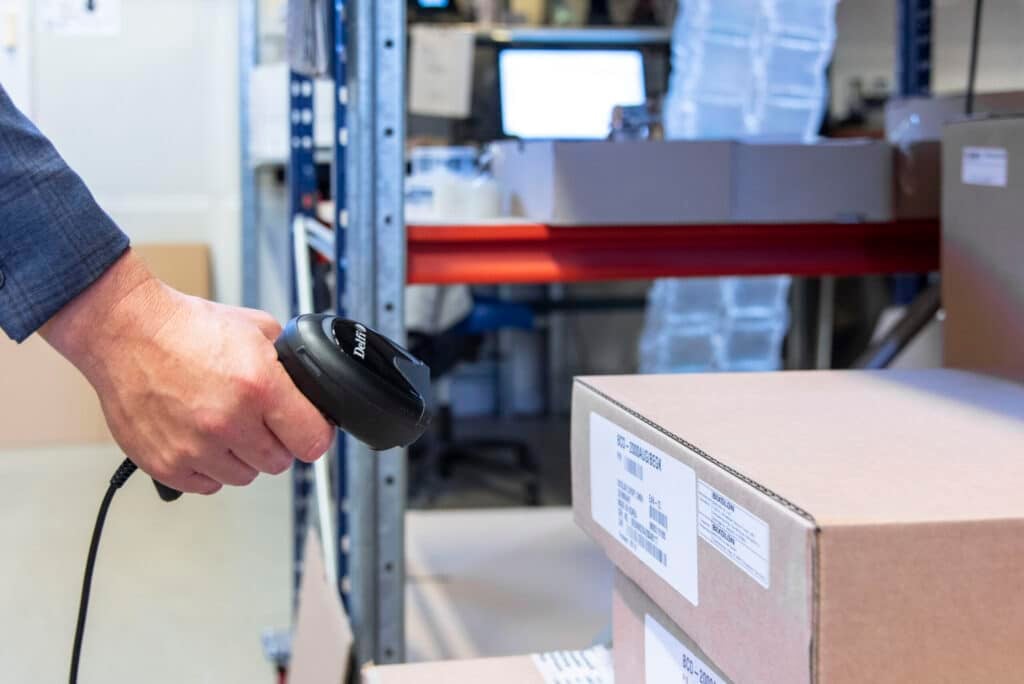
Which one should you choose?
- If you only work with traditional barcodes: Choose a 1D hand scanner.
- For flexibility and future-proofing: Invest in a 2D handheld scanner that can also scan 1D codes.
Quick tip: Many businesses are switching to 2D handheld scanners to meet future needs. If you’re considering digital solutions, a 2D scanner is a good choice.
Robustness – does your hand scanner need to withstand shock, dust and water?
When investing in the best handheld scanner for your business, it’s important to consider the environment it will be used in. Do you work in a warehouse, busy shop or industrial hall? Then your handheld scanner needs to be able to withstand shocks, drops, dust and maybe even liquid.
Why is resilience important?
If your handheld scanner is often dropped, exposed to dust or used in demanding environments, choose a robust model with a high IP rating. A standard office handheld scanner rarely lasts long in an industrial environment where it is exposed to daily wear and tear.
Understand the IP rating – how protected is your handheld scanner?
The IP (Ingress Protection) rating indicates how well a device is protected against dust and water.
Examples of IP classifications:
- IP42 – Protects against small dust particles and light water dripping. Perfect for retail.
- IP65 – Resistant to dust, dirt and water jets. Ideal for warehouses and production.
- IP67 – Dustproof and waterproof to a certain depth. Used in industrial and outdoor environments.
Drop resistance – can your hand scanner withstand an accident?
Many rugged handheld scanners are designed to survive drops of 1.5-2 meters on concrete, which is crucial in high activity work environments.
Which robustness should you choose?
- Retail & Office: A standard handheld scanner with IP42 or lower is often sufficient.
- Warehouse & Logistics: Choose an IP65 handheld scanner that can withstand shock, dust and moisture.
- Industry & demanding environments: An IP67 handheld scanner that is completely dustproof and waterproof is the best choice.
Quick tip: If you work in an environment where the handheld scanner is often dropped or exposed to dirt, consider a model with a rubberized construction for extra protection.
Scanning distance and speed – what’s most important to you?
The performance of a handheld scanner depends on its scanning distance and speed. These factors are crucial to the workflow and efficiency of your business.
Why does scan distance matter?
Scanning distance determines how far away a handheld scanner can read a barcode. If your employees need to scan items close to the checkout, a different type of scanner is required than those working in large warehouses or on high shelves.
Different scanning distances:
- Short distance (0-50 cm): Perfect for crates and production lines where items are scanned in close proximity.
- Medium distance (up to 2 meters): Ideal for picking items in stock.
- Long distance (up to 15 meters): Typically used in large warehouses where employees scan from trucks or high racks.
Scanning speed – how fast should you be able to scan?
The speed at which a hand scanner reads a barcode is of great importance in busy environments. A slow scanner can cause bottlenecks at the checkout or in the warehouse.
How do you choose the right speed?
- Standard speed: For small shops and offices where scanning is not constant.
- High speed: For retail where many items are scanned in a row.
- Extreme speed: For industrial processes where scanning is done in motion, such as conveyor belts.
Which scanner should you choose?
- Shop and office: Standard scanner with short range and medium speed.
- Warehouse and logistics: High-speed long-range scanner.
- Industry and automation: High-precision scanner with fast reading, even in motion.
Remember that a faster scanner can reduce waiting time and improve productivity, especially in busy environments.

Integration with your IT systems
When choosing the best hand scanner for your business, it’s important to ensure it integrates seamlessly with your existing systems. A hand scanner shouldn’t just be able to read barcodes – it should also be able to send data directly to your ERP, inventory management or POS system.
What systems does the hand scanner need to work with?
To ensure efficient workflow, your hand scanner must integrate with the following systems:
- Enterprise Resource Planning (ERP) systems: SAP, Microsoft Dynamics, Oracle or other inventory management and financial systems.
- WMS (Warehouse Management System): Warehouse management software that automates goods receiving and shipping.
- POS (Point of Sale): Retail checkout systems where fast scanning is essential.
- Mobile devices and tablets: Many modern hand scanners support direct connection to mobile devices via Bluetooth or WiFi.
Connection types – what fits your infrastructure?
Handheld scanners can be connected in different ways depending on your setup:
- The USB cable: Plug & Play solution where the scanner connects directly to a computer or POS system.
- Bluetooth: Perfect for mobile solutions and tablets where cables are impractical.
- WiFi: For larger warehouse management systems where real-time data is needed.
- RFID compatibility: If your business works with RFID tags, your handheld scanner should be able to read them too.
Plug & Play or configurable solution?
Some handheld scanners are Plug & Play, which means they work instantly without setup. Others require configuration if they are to work with a specialized system.
- Plug & Play: Quick setup, ideal for small businesses.
- Configurable solutions: Flexible, but requires software and driver setup.
How do you choose the right integration?
- Do you have a standard POS system? Choose a Plug & Play handheld scanner with USB or Bluetooth.
- Do you have a complex inventory management system? Consider a WiFi or ERP-compatible handheld scanner.
- Do you have employees working on the move? Bluetooth scanners are the obvious choice.
A good integration means your employees can scan items effortlessly, reduce errors and optimize workflows.
Battery life – avoid downtime
Battery life is crucial when choosing the best handheld scanner for your business – especially if it will be used wirelessly. A scanner that runs out of power in the middle of a job can cause unnecessary delays.
For occasional use, such as in retail, eight hours of battery life is often enough. In warehouses where scanning is constant, a handheld scanner should be able to hold power for at least 12-16 hours. Some models have interchangeable batteries so a new battery can be quickly inserted, while others charge in a docking station.
Charging time is also important. A fast charge can be an advantage if the scanner is used around the clock. Companies with high usage often choose models with extra batteries so that work is never interrupted.
When choosing a wireless handheld scanner, you should therefore consider battery life, charging time and the ability to change batteries to avoid downtime for your business.
Price vs. quality – what are you paying for?
When investing in the best hand scanner for your business, price is often a deciding factor. But what are you really paying for?
Budget-friendly models can be a good choice for smaller shops or occasional use where scanning speed and robustness requirements are limited. However, they may have a shorter lifespan and fewer advanced features.
Mid-range models offer better build quality, higher scanning speed and longer battery life. They are suitable for warehouses and busy shops where reliability is important.
Premium handheld scanners are often designed for demanding environments with high scanning speed, long range and robustness. These models are typically IP65 or higher, meaning they can withstand shock, dust and water.
The most important thing is to match the price with your needs. A more expensive handheld scanner can be a better investment if it saves time, minimizes errors and lasts longer.
Find the best hand scanner for your business
Choosing the best handheld scanner is all about finding a solution that fits your business needs. Should the scanner be wired or wireless? Should it be able to read 1D or 2D codes? Should it be robust and have a long battery life?
To make the choice easier, we offer a wide range of handheld scanners for all industries – from retail to industrial and logistics. Whether you’re looking for a fast and flexible model or an extremely robust scanner for demanding environments, we have the right solution.
Need help finding the right hand scanner? Contact our experts for personal advice or view our range of handheld scanners here.

